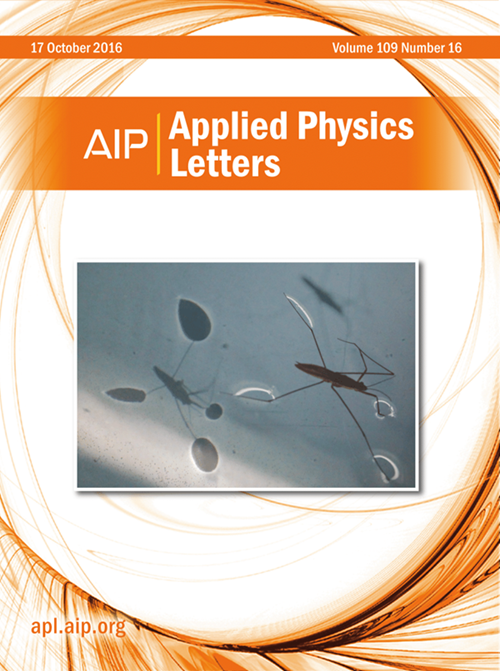GaN/AlN二维空穴气体的速度场测量
IF 3.6
2区 物理与天体物理
Q2 PHYSICS, APPLIED
引用次数: 0
摘要
我们报告了测量和改进的分析方法,以表征室温和低温下GaN/AlN异质结构中极化诱导的二维空穴气体的速度场特征,使用脉冲电压和电流通过微米尺度的收缩。这些高偏置测量是通过在低温下保持足够透明的欧姆触点(在10 mA/mm电流以上50 Ω mm)而实现的。我们观察到,当空穴密度为4×1013 cm−2时,其室温饱和速度为(2.1±0.2)×106 cm/s,相关迁移率为~ 7-12 cm2/V s,在4.2 K时,该速度增加到(4.4±0.4)×106 cm/s,相关迁移率为~ 25-50 cm2/V s。在这种几何结构中,测量到的集成空穴饱和速度,适用于场效应晶体管通道,低于在轻掺杂n型三维体GaN中测量到的空穴(6.63 ×106 cm/s)。由于二维空穴气体的二维几何形状和高载流子密度,以及凹槽蚀刻导致的空穴迁移率下降。在不同的表面边界条件下,用体积密度泛函理论和二维全频带实空间细胞蒙特卡罗模拟验证了测量的速度场轮廓。本文章由计算机程序翻译,如有差异,请以英文原文为准。
Velocity-field measurements in a GaN/AlN two-dimensional hole gas
We report measurements and an improved analysis methodology to characterize the velocity-field characteristics of a polarization-induced two-dimensional hole gas in a GaN/AlN heterostructure at both room and cryogenic temperatures, using pulsed voltage and current through a micrometer-scale constriction. These high-bias measurements are made possible by Ohmic contacts that remain sufficiently transparent (<50 Ω mm above 10 mA/mm current) at cryogenic temperatures. We observe a room temperature saturation velocity of (2.1 ± 0.2)×106 cm/s and associated mobility of ∼7–12 cm2/V s for a hole density of 4×1013 cm−2, which increases to (4.4 ± 0.4)×106 cm/s at 4.2 K, with an associated mobility of ∼25–50 cm2/V s. The measured ensemble hole saturation velocity in this geometry, which is suitable for field-effect transistor channels, is lower than that of holes measured in lightly-doped n-type 3D bulk GaN (6.63 ×106 cm/s), owing to the 2D geometry and high carrier density of the two-dimensional hole gas, and degraded hole mobility from recess etching. Measured velocity-field contours are corroborated against bulk density functional theory and two-dimensional full-band real-space cellular Monte Carlo simulations under different surface boundary conditions.
求助全文
通过发布文献求助,成功后即可免费获取论文全文。
去求助
来源期刊

Applied Physics Letters
物理-物理:应用
CiteScore
6.40
自引率
10.00%
发文量
1821
审稿时长
1.6 months
期刊介绍:
Applied Physics Letters (APL) features concise, up-to-date reports on significant new findings in applied physics. Emphasizing rapid dissemination of key data and new physical insights, APL offers prompt publication of new experimental and theoretical papers reporting applications of physics phenomena to all branches of science, engineering, and modern technology.
In addition to regular articles, the journal also publishes invited Fast Track, Perspectives, and in-depth Editorials which report on cutting-edge areas in applied physics.
APL Perspectives are forward-looking invited letters which highlight recent developments or discoveries. Emphasis is placed on very recent developments, potentially disruptive technologies, open questions and possible solutions. They also include a mini-roadmap detailing where the community should direct efforts in order for the phenomena to be viable for application and the challenges associated with meeting that performance threshold. Perspectives are characterized by personal viewpoints and opinions of recognized experts in the field.
Fast Track articles are invited original research articles that report results that are particularly novel and important or provide a significant advancement in an emerging field. Because of the urgency and scientific importance of the work, the peer review process is accelerated. If, during the review process, it becomes apparent that the paper does not meet the Fast Track criterion, it is returned to a normal track.
 求助内容:
求助内容: 应助结果提醒方式:
应助结果提醒方式:


